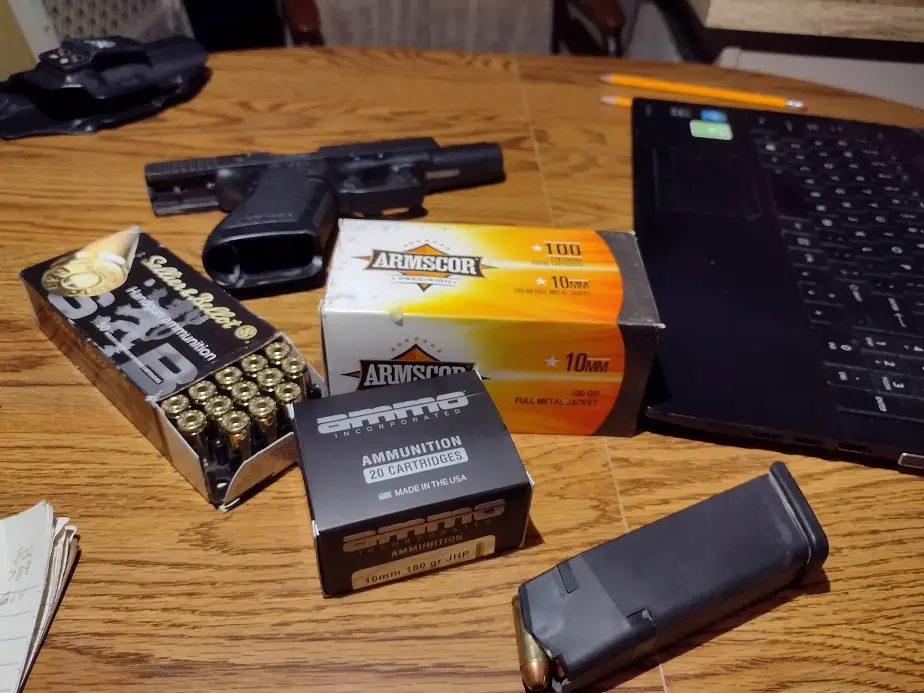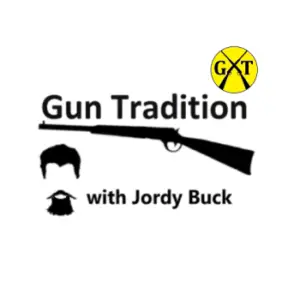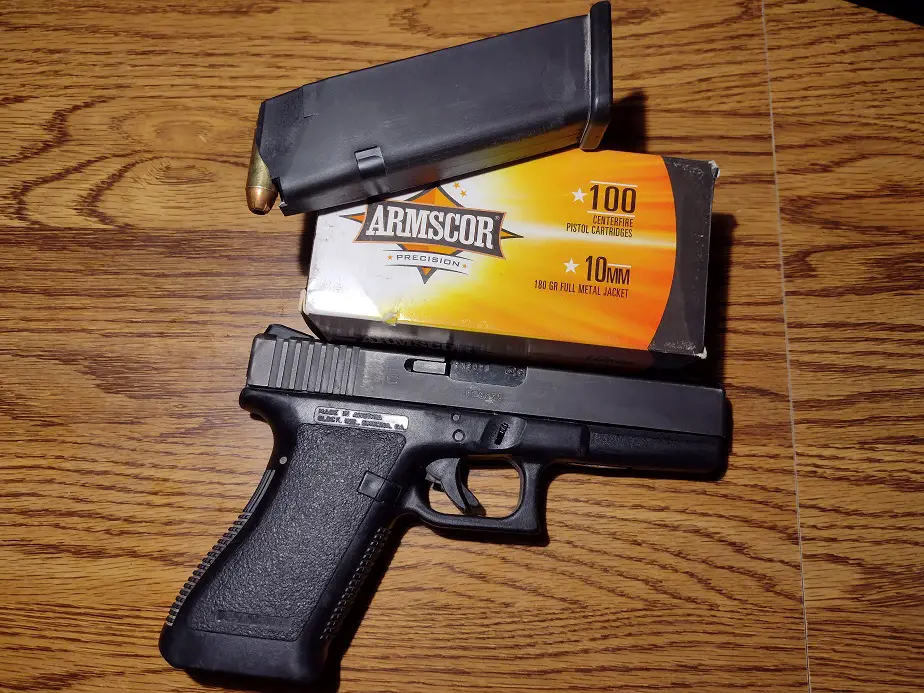Having shot both and carried a 10mm for years, I’m amazed at the potential in both cartridges.
The 357 Magnum has more potential energy than a 10mm AUTO. According to S.A.A.M.I, the 357 Magnum has more case capacity and higher max pressure. The 357 has a wider selection of bullets and fires at a greater velocity than the 10mm with the same weight bullets and penetrates marginally better.
Both the .357 and 10mm have unique strengths and limitations. After hours of research, I’ve compiled everything you want to know about the measurements and ballistics of both cartridges.

Max power loads for 10mm Auto and 357 Magnum compared (manufacturer specs)
| Manufacturer | Caliber | Bullet Type | Weight-grains | Velocity-fps | Energy-ft/lbs. |
| *Buffalo Bore | .357 | hardcast | 180 | 1400 | 783 |
| Buffalo Bore | 10mm | Hardcast | 180 | 1200 | 703 |
| Underwood | .357 | fmj | 180 | 1300 | 675 |
| Underwood | 10mm | fmj | 180 | 1300 | 675 |
*Buffalo Bore loads this 357 Magnum ammo to levels that may cause reliability issues in lightweight, aluminum-framed revolvers.
First of all, these are all some powerful handgun loads, around twice as powerful as a 9mm. Second, notice there isn’t a huge difference. Here’s a tricky fact, the velocity of a pistol bullet can vary as much as 200 fps among pistols with similar-sized barrels. There’s a lot of play in those numbers.
Some manufacturers try and take that into account by giving you an average velocity within a standard range, while some use longer than average barrels with tight chambers to pump up the numbers. In my experience, both Underwood and Buffalo Bore give us information reflecting actual shooting conditions.
A Scenario called “Crimp Jump” is when a gun revolver recoils so much the next bullet slides out of the case a bit. Crimp Jump isn’t necesarily dangerous, but it will cause the cylinder to jam. The case mouth is crimped around the bullet, but in extreme cases, it can jump the crimp.
It shouldn’t be an issue in any steel-framed revolver. Aluminum revolvers are lightweight and will recoil more severely. They may have trouble with Crimp Jump. Aluminum 357 revolvers are popular and ammo companies began downloading the power of their ammo to suit.
https://www.avantlink.com/click.php?tool_type=cl&merchant_id=ba7397a2-0616-4b0d-b1d2-c94b8d995b88&website_id=051d5712-1735-4153-abc8-2cf6ddb2df16&url=https%3A%2F%2Fwww.bearcreekarsenal.com%2Fcalibers%2F10mm%2F10mm-rifles.htmlIf you are interested in a 10mm for hunting or home defense, consider an AR rifle or AR pistol from Bear Creek Arsenal. The longer barrels double the power and improve accuracy and handling.
I own, hunt with, and recommend Bear Creek Arsenal AR rifles and uppers. They’re durable and reliable.
Check out the 10mm AR Rifles Here
Check out the 10mm AR pistols here!
No company loads hotter 357 magnum ammo than Buffalo Bore. They put a heavy crimp on their bullets, and recommend against using their ammo in an aluminum-framed revolver. Other companies simply don’t offer a max power load in an effort to avoid trouble.
Those are truly some maximum power rounds. They are designed to, or near to the allowed are maximums for the two cartridges. Most ammunition available in those calibers was not designed to fully take advantage of either cartridge’s potential.
It’s mainly in an effort to keep prices low, and to keep the recoil down. I’ll admit that low-power 10mm ammo makes for an easy shooting gun, especially if I’m shooting several hundred rounds in a day. Also, some bullets, namely certain hollow points, may not perform well at too high of speeds.
I used all 180-grain bullets in the first chart just to show a decent apple to apple comparison, ballistics-wise. 180 grain 357 is a rare exception really. Most of the stuff is significantly lighter. Let’s take a look at a comparison from the same manufacturer and product line in more regular offerings.
Standard Power Loads for 10mm AUTO and .357 Magnum (manufacturer specs)
| Manufacturer | Caliber | Bullet Type | Weight grains | Velocity fps | Energy ft/lbs. |
| federal | 10mm | fmj | 180 | 1030 | 242 |
| federal | 357 | fmj | 158 | 1240 | 539 |
| Remington UMC | 10mm | fmj | 180 | 1030 | 424 |
| Remington UMC | 357 | swc | 158 | 1235 | 535 |
Is 10mm Bigger than a 357 magnum?
The 10mm is 40 caliber and the 357 is 35 caliber. 10mm brass is shorter and holds less gunpowder than 357. The 10mm fires bullets from 175 grains going 1325 fps, to 230-grain bullets going 1100 fps. The 357 Magnum fires bullets from 125 grains going 1700 fps to 180-grain bullets going 1400 fps.
10mm AUTO vs 357 Magnum Cartridge Specifications
| Cartridge | Case Type | Bullet Dia. | Neck Dia. | Base Dia. | Rim Dia. | Case Length | Overall Length |
| 10mm | Rimmed Straightwall | .400 | .423 | .423 | .424 | .922 | 1.260 |
| .357 Mag | Rimless Straightwall | .357 | .379 | .379 | .440 | 1.29 | 1.510 |
The 357 magnum is clearly taller and has a significantly larger case capacity. This allows it to achieve impressive pressures and velocities.
10mm AUTO vs 357 Magnum S.A.A.M.I. Max Pressure and Case Capacity
| Cartridge | Max Pressure | Case Capacity Volume of H2o in grains |
| 10mm | 33,000 psi | 24.2 |
| .357 | 35,000 psi | 26.1 |
Is 10mm More Powerful Than a 357 Magnum?
The 357 Magnum is a more powerful round than the 10mm. The most powerful 357 Magnum factory ammo has listed energy of 899 ft/lbs. That’s 24.5% more power than the most powerful 10mm round. The 357 is a faster shooting cartridge than 10mm, even with the same bullet weight.
10mm Auto vs. 357 Magnum defensive loads (Manufacturer data)
| Caliber | Manufacturer | Bullet weight grains | Velocity fps | Energy ft/lbs. |
| 357 Magnum | Hornady | 125 | 1500 | 624 |
| Sig Sauer | 125 | 1450 | 583 | |
| Winchester | 145 | 1290 | 559 | |
| Federal | 158 | 1240 | 539 | |
| Black Hills | 125 | 1500 | 625 | |
| Underwood | 158 | 1500 | 789 | |
| Underwood | 125 | 1700 | 802 | |
| Buffalo Bore | 180 | 1500 | 899 | |
| 10mm AUTO | Hornady | 180 | 1180 | 556 |
| Sig Sauer | 180 | 1250 | 624 | |
| Winchester | 175 | 1200 | 559 | |
| Federal | 180 | 1030 | 424 | |
| Federal | 200 | 1100 | 537 | |
| Underwood | 180 | 1250 | 624 | |
| Buffalo Bore | 180 | 1350 | 728 |
*The values reported here are optimal performance. It’s normal to see velocities less than these in individual firearms.
The 10mm Auto isn’t a 357 Magnum. The 10mm was designed as a compromise round between the powerful 357 revolvers and the 45acp semi-auto pistol. The 357 was invaluable with law enforcement for decades. Before the 357, the 38 Special wasn’t quite enough when it came to barrier penetration.
The 357 was a true game-changer in the world of handguns. It was more powerful than people thought a handgun could be. It was a new height reached in ballistics. Its issue was the fact that being a revolver, it’s practically limited to about 6 shots before reloading.
The 9mm and 45 ACP were accepted cartridges at the time, but just lacked the power and speed required for some of the tough jobs. Jeff Cooper, a gun expert of yesteryear, was convinced that a semi-auto could be sufficient, given the right loadings.
The idea was a semi-auto shooting a 40-caliber bullet weighing 200 grains and attaining a velocity of 1200 fps. It was surmised that a bullet like that would wound similar to the 35 caliber 158-grain bullet going 1400 fps from the 357 Magnum. And, still have good barrier penetration.
There are 3 main advantages to a 10mm over a 357. The first is weight. The heaviest 357 bullet is 180 grains while the heaviest 10mm bullet is 230 grains. The 10mm can fire bullets as heavy as common 45acp, and do it a bit faster than the 45. The 10mm is to the 45acp, wat the 357 is to the 10mm.

Why 10mm is Better than 357 Magnum
10mm pistols are easier to handle and fire accurately in a stressful situation than a 357 revolver. A 10mm semi-auto holds up to 250% more ammo than a 6-shot 357 Magnum revolver. Both have similar power levels and the 10mm semi-auto is easier to shoot quickly than a 357 revolver.
My personal choice is the 10mm, specifically the Glock 20. The fact of having significantly more ammo in m gun, and having a faster shooting gun is well worth the difference in power for me personally. For defensive use, the 10mm has large benefits over the 357 Magnum.
If you are talking hu8nting, then the 357 starts looking pretty nice. The amazing trigger pull when fired in single-action mode (cocking the hammer back first) benefits precise hunting accuracy. Firing this way in a defensive situation is dangerous because the trigger will go off when barely touched and because it takes too long to get shots off that way.
However, it’s perfect for target shooting or hunting where you can take your time and pay careful attention to your trigger pull. All the experts seem to agree that a revolver requires significantly more skill to fire quickly, is trickier to reload, and that you are limiting your chances due to having less ammo. in the gun.
I’m not saying that having a semi-auto is grounds for being lazy and not becoming proficient, but that they are more intuitive to handle quickly and they better lend themselves to an ‘Oh Crap” scenario.
I said there is more choices in 357 ammo, but that’s starting to change. the 10mm is somewhat replacing the 357 on gun store shelves. I can usually find more 10mm ammo in town than I can 357. Albeit less variety, but still I find it more regularly.
The 10mm is fast becoming popular and every year more companies are adding 10mm ammo for hunting, target shooting, and defensive applications.
The 357 Magnum is becoming less popular every year. I wrote an article about that last year. Here’s a link to it.

